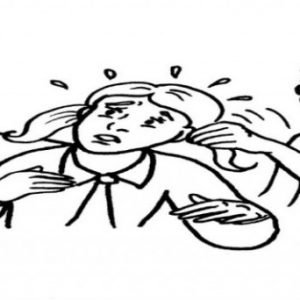
When a boy pulls a little girl’s pony tail, it could be a sign of affection. However what’s the difference between pulling your own hair versus a little boy doing it?
Trichotillomania is a hair pulling disorder that affects approximately 1 to 5 % of the population. (1–3) The onset of trichotillomania typically occurs in childhood, at approximately 11 years old. (4) Before the age of 6, it is more likely to appear in boys. (5) There is no need for medical intervention prior to the age of 5. (6) Parents can oversee and monitor the treatment process, with the aid of a therapist or doctor. Between the ages of 6 to 17, girls are more likely than boys to have this condition. (7) Avoidance of physical activities like swimming and socializing in a large group can occur, possibly due to teasing from peers. (8)
There are several ways to help mask the traces of trichotillomania while your child is recovering. Use of wigs, moisturizing products, or specific hair styling techniques, can be your best bet while treating trichotillomania.
Trichotillomania can also be present in college aged students. It was found that 0.6%, out of over 2,000 college students have had trichotillomania all their lives. (1) A study that was conducted examining the link between stealing and mental health disorders showed that 17.6% of college aged students with trichotillomania had the urge to steal. (9)
To summarize our series, trichotillomania it is a difficult to treat hair pulling disorder. It can co-occur with other medical conditions and can be linked to anxiety and depression. There can be feelings of tension, pleasure or relief during pulling. The most common pulling site is the scalp and there are several serious health consequences for those who eat plucked hairs. Treatment options can range from medication to comprehensive behavior therapy. Please don’t be afraid to talk with your doctor or family members if you struggle with trichotillomania.
Article by: Sarah Versteeg MSc, Mediprobe Research Inc.
- Christenson GA, Pyle RL, Mitchell JE. Estimated lifetime prevalence of trichotillomania in college students. J Clin Psychiatry. 1991 Oct;52(10):415–7.
- Grant JE, Levine L, Kim D, Potenza MN. Impulse control disorders in adult psychiatric inpatients. Am J Psychiatry. 2005 Nov;162(11):2184–8.
- American Psychiatric Association. Diagnostic and Statistical Manual of Mental Disorders. 5th Edition. Arlington, VA: American Psychiatric Publishing; 2013.
- Cohen LJ, Stein DJ, Simeon D, Spadaccini E, Rosen J, Aronowitz B, et al. Clinical profile, comorbidity, and treatment history in 123 hair pullers: a survey study. J Clin Psychiatry. 1995 Jul;56(7):319–26.
- Hamdan-Allen G. Trichotillomania in childhood. Acta Psychiatr Scand. 1991 Apr;83(4):241–3.
- Keuthen NJ, O’Sullivan RL, Sprich-Buckminster S. Trichotillomania: current issues in conceptualization and treatment. Psychother Psychosom. 1998 Oct;67(4-5):202–13.
- Muller SA, Winkelmann RK. Trichotillomania. A clinicopathologic study of 24 cases. Arch Dermatol. 1972 Apr;105(4):535–40.
- Odlaug BL, Kim SW, Grant JE. Quality of life and clinical severity in pathological skin picking and trichotillomania. J Anxiety Disord. 2010 Dec;24(8):823–9.
- Grant JE, Odlaug BL, Lust K, Christenson G. Characteristics and correlates of stealing in college students. Crim Behav Ment Health CBMH. 2015 Dec 9;












